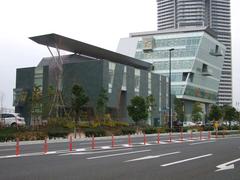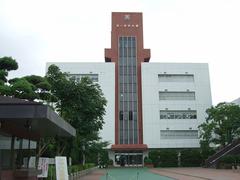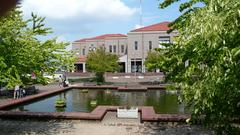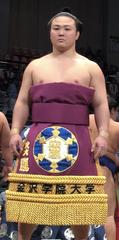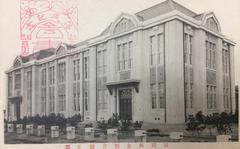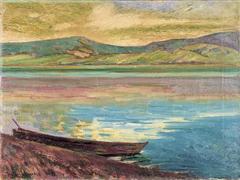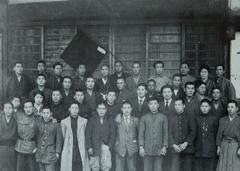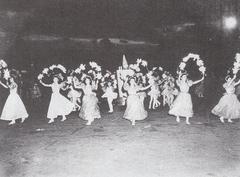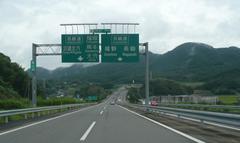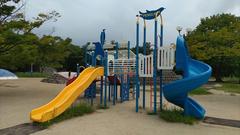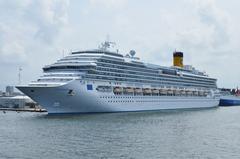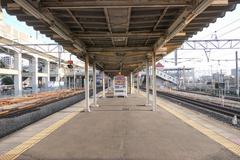
Shikaumi Shrine Visiting Hours, Tickets, and Comprehensive Guide to Fukuoka’s Historical Coastal Gem
Date: 04/07/2025
Introduction
Shikaumi Shrine (志賀海神社), set amid the coastal beauty of Shikanoshima Island in Fukuoka Prefecture, stands as a vital testament to Japan’s maritime heritage and Shinto spirituality. Revered as the spiritual home of the seafaring Azumi people and head shrine for all Watatsumi sea deity shrines, Shikaumi offers visitors a rare intersection of myth, history, and living tradition. Its legendary founding by Empress Jingū, ancient purification ceremonies, and storied role as a guardian of the sea have established it as one of Fukuoka’s most treasured cultural sites. This detailed guide covers everything you need to know for a meaningful visit—history, festivals, visiting hours, ticketing, accessibility, and local highlights—along with tips for making the most of your time on Shikanoshima Island.
Historical and Cultural Background
Origins and Mythology
Shikaumi Shrine’s roots stretch back to the 3rd–7th centuries CE when it was central to the Azumi people, renowned mariners who dominated northern Kyushu (JapanToday). The shrine is intimately linked to the sea deity Watatsumi and is the principal shrine for all Watatsumi and Kai shrines in Japan (KyushuTV). According to legend, Empress Jingū established Shikaumi Shrine after launching her campaign to the Korean peninsula, with both her and her son, Emperor Ōjin, enshrined alongside Tamayorihime no Kami (Shinto Miraheze, Wikipedia).
The Three Watatsumi Deities
Central to the shrine are the Three Watatsumi Deities, each representing a different realm of the sea:
- Uwatsu Watatsumi no Kami: Guardian of the sea’s surface
- Nakatsu Watatsumi no Kami: Overseer of the sea’s middle depths
- Sokotsu Watatsumi no Kami: Protector of the sea’s deepest realm
These deities, originally worshipped at separate sites on Shikanoshima, reflect the Azumi’s reliance on the sea for survival and prosperity (Visit Japan Vegetarian). The auxiliary shrines—Nakatsumiyagū on Katsuma Beach and Okitsumiyagū on a tidal islet—are accessible only at certain times (Shinto Miraheze).
Historical Events and Maritime Role
Shikaumi Shrine’s prominent location on the Genkai Sea made it a defensive and spiritual bastion, especially during the Mongol invasions of the 13th century (Wikipedia). Sailors and fishermen have long sought the shrine’s protection before venturing into unpredictable waters (KyushuTV).
Rituals, Festivals, and Heritage
The shrine preserves rare customs such as the Oshioi purification ritual, in which sacred sand, not water, is used for spiritual cleansing (Visit Japan Vegetarian). The biennial Gojinkosai festival—recognized as an intangible cultural asset—features processions and rites dedicated to the sea gods (Shinto Miraheze). The deer motif, integral to the Azumi, is celebrated in both architecture and ritual, with the Rokkakuko repository holding over 10,000 antlers (Visit Japan Vegetarian).
Architectural Features
Shikaumi Shrine’s precincts feature:
- Main Hall (Utsumiyagū): The spiritual heart of the shrine
- Auxiliary Shrines: Including Okitsumiyagū (on a tidal islet) and Nakatsumiyagū (Katsuma Beach), reflecting the three Watatsumi realms
- Yamanokami Shrine: Renowned for prosperity rituals and wallet exchanges
- Deer Antler Repository (Rokkakuko): A unique architectural and spiritual feature
- Historic Pagoda: Designated as an important cultural property (Visit Japan Vegetarian)
Practical Visitor Information
Visiting Hours
- Standard Hours: 8:30 AM – 5:00 PM (last entry 4:30 PM)
- Seasonal Variation: Some sources note earlier opening (as early as 5:30 AM) in summer and extended hours for New Year’s hatsumode and sunrise viewing (arne.media)
Admission & Tickets
- Entry: Free to the main shrine grounds and most features
- Special Events/Exhibitions: May require a small fee (typically around 500 yen). Confirm on-site or via official site (travel.gaijinpot.com)
Accessibility
- Grounds: Mostly accessible, with paved paths and ramps; some steps remain
- Auxiliary Shrines: Okitsumiyagū requires walking across a sandbar at low tide and is not accessible for wheelchairs or those with mobility challenges
- Facilities: Restrooms available; parking on-site; limited English signage
Getting There
- By Ferry: From Hakata Bayside Place Ferry Terminal to Shikanoshima Port (approx. 33 minutes); shrine is a 10-minute walk (gofukuoka.jp)
- By Bus: From JR Saitozaki Station, take Nishitetsu bus (routes 1 or 21) to “Shikanoshima” stop, then walk 10 minutes
- By Car: Free parking is available (arne.media)
Best Times to Visit
- Seasonal Highlights: Spring and autumn for pleasant weather and festivals; New Year’s Day sunrise for hatsumode
- Tide Considerations: Check tide charts if planning to access Okitsumiyagū
Facilities & Amenities
- Restrooms, gift shop, and nearby eateries featuring local seafood
- Shikanoshima Island Centre “Shima no Sachi” offers souvenirs and refreshments (gofukuoka.jp)
Shrine Grounds and Notable Features
Main Approach and Structures
- Stone-paved sando with mature trees and torii gates
- Romon (tower gate) leading to the honden (main sanctuary)
- Haiden (worship hall) with ema (prayer plaques) and omikuji (fortunes)
- Temizuya purification fountains for ritual cleansing (note.com)
Unique Sites
- Okitsu-gu: Subsidiary shrine accessible at low tide across a sandbar
- Deer Antler Repository: Over 10,000 antlers, central to Azumi tradition
- Man’yōshū Poetry Monument: Celebrating ancient literary connections
- Historic Korean Bell: Testimony to maritime exchange, with English explanations
- Auxiliary Shrines & Sacred Trees: Sites for navigation deities and veneration of ancient camphor/pine trees wrapped in sacred shimenawa ropes
Cultural and Ritual Highlights
Festivals & Rituals
- Gojinkosai (biennial): Grand procession and sea deity rites
- Ho-sha-sai (January): Archery ritual for maritime safety
- Yamaho-me Matsuri: Spring and autumn festivals for land and sea blessings (note.com)
- New Year’s Sunrise: Shrine opens at midnight for hatsumode, a major local event (arne.media)
Ritual Practices
- Oshioi purification: Using sacred sand for cleansing
- Standard prayer: Bow twice, clap twice, pray, then bow once
Amulets, Charms, and Souvenirs
Unique omamori and fortunes include:
- Kaiun Ryuto-mikuji: Dragon Head Fortune
- Ryujin Kachimamori: Dragon God Victory Amulet
- Flying Fish Fortune: Playfully themed charm (arne.media)
Photography & Scenic Spots
- Remote worship site: Panoramic sea views, especially at sunrise
- Deer Antler Repository and Main Shrine: Popular for photos
- Photography permitted throughout most of the grounds; refrain from photographing inside the honden
Nearby Attractions
- Kinin (Gold Seal) Park: Site of the famed “King of Na” gold seal (crossroadfukuoka.jp)
- Shikanoshima Museum: Maritime history exhibits
- Cycling routes, Shiomi Park, Katsuma Beach: Ideal for outdoor enthusiasts
- Local seafood restaurants near the ferry terminal
Visitor Etiquette & Tips
- Purification: Use the temizuya before entering
- Respect: Bow at torii, maintain a quiet demeanor, and avoid disruptive behavior
- Cash preferred for amulets and offerings
- Best times: Early mornings or weekdays for tranquility
- Language: Limited English signage—bring translation apps if needed
Frequently Asked Questions (FAQ)
Q: What are Shikaumi Shrine’s visiting hours?
A: Generally 8:30 AM to 5:00 PM (last entry 4:30 PM); seasonal variations may apply.
Q: Is there an entrance fee?
A: Admission is free; special events or exhibitions may have a small fee.
Q: How do I get to Okitsu-gu?
A: Accessible on foot only at low tide via a sandbar. Check local tide charts.
Q: Are guided tours available?
A: Occasional tours are organized through local tourism offices or the Shikanoshima Museum; inquire in advance.
Q: Is the shrine accessible for visitors with mobility issues?
A: Main grounds are mostly flat and accessible; some auxiliary areas have steps or natural terrain.
Q: Can I take photos?
A: Yes, except inside the honden (main sanctuary).
Q: Are pets allowed?
A: Pets are generally not permitted within the shrine precincts.
Contact and Official Information
- Address: 877 Shikanoshima, Higashi-ku, Fukuoka City, Fukuoka Prefecture
- Phone: 092-603-6501
- Official Website: Shikaumi Shrine Official Site
- Instagram: @shikaumijinja_official
For latest updates on events and hours, consult the official website.
Conclusion
Shikaumi Shrine is a destination where history, spirituality, and natural beauty converge. Its free admission, accessible grounds, and rich cultural traditions make it welcoming for all visitors—whether you seek spiritual reflection, historical insight, or a serene coastal escape. Attend a festival, witness sunrise rituals, explore the treasures of Shikanoshima, and immerse yourself in the living spirit of Japan’s maritime past.
For further travel guidance, download the Audiala app and follow us on social media for event updates and insider tips.
References
- JapanToday: Shikaumi Shrine said to be founded by legendary Empress Jingu
- KyushuTV: Fukuoka Shikaumi Shrine
- Shinto Miraheze: Shikaumi Shrine
- Wikipedia: Shikaumi Shrine
- Visit Japan Vegetarian: Shikanoshima Island Guide
- Japan Experience: Shikanoshima Attractions
- gofukuoka.jp: Shikaumi Shrine & Shikanoshima
- arne.media: Shikaumi Shrine Guide
- travel.gaijinpot.com: Shikaumi Shrine
- crossroadfukuoka.jp: Shikanoshima Island Highlights
- note.com: Shikaumi Shrine Features


